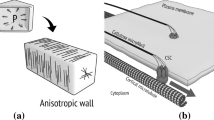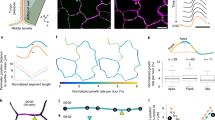Abstract
The intertwining between mechanics and developmental biology is extensively studied at the shoot apical meristem of land plants. Indeed, plant morphogenesis heavily relies on mechanics; tissue deformations are fueled by turgor-induced forces, and cell mechanosensitivity plays a major regulatory role in this dynamics. Since measurements of forces in growing meristems are still out of reach, our current knowledge relies mainly on theoretical and numerical models. So far, these modeling efforts have been mostly focusing on the epidermis, where aerial organs are initiated. In many models, the epidermis is assimilated to its outermost cell walls and described as a thin continuous shell under pressure, thereby neglecting the inner walls. There is, however, growing experimental evidence suggesting a significant mechanical role of these inner walls. The aim of this work is to investigate the influence of inner walls on the mechanical homeostasis of meristematic tissues. To this end, we simulated numerically the effect of turgor-induced loading, both in realistic flower buds and in more abstract structures. These simulations were performed using finite element meshes with subcellular resolution. Our analysis sheds light on the mechanics of growing plants by revealing the strong influence of inner walls on the epidermis mechanical stress pattern especially in negatively curved regions. Our simulations also display some strong and unsuspected features, such as a correlation between stress intensity and cell size, as well as differential response to loading between epidermal and inner cells. Finally, we monitored the time evolution of the mechanical stresses felt by each cell and its descendants during the early steps of flower morphogenesis.








Similar content being viewed by others
References
Ali O, Mirabet V, Godin C, Traas J (2014) Physical models of plant development. Annu Rev Cell Dev Biol 30:59–78
Armezzani A, Abad U, Ali O, Robin AA, Vachez L, Larrieu A, Mellerowicz EJ, Taconnat L, Battu V, Stanislas T, Liu M, Vernoux T, Traas J, Sassi M (2018) Transcriptional induction of cell wall remodelling genes is coupled to microtubule-driven growth isotropy at the shoot apex in Arabidopsis. Development 145(11):dev162255–11
Bassel GW, Stamm P, Mosca G, de Reuille PB, Gibbs DJ, Winter R, Janka A, Holdsworth MJ, Smith RS (2014) Mechanical constraints imposed by 3D cellular geometry and arrangement modulate growth patterns in the Arabidopsis embryo. Proc Natl Acad Sci USA 111(23):8685–8690
Beauzamy L, Louveaux M, Hamant O, Boudaoud A (2015) Mechanically, the shoot apical meristem of arabidopsis behaves like a shell inflated by a pressure of about 1 MPa. Front Plant Sci 6:1038
Boudon F, Chopard J, Ali O, Gilles B, Hamant O, Boudaoud A, Traas J, Godin C (2015) A computational framework for 3D mechanical modeling of plant morphogenesis with cellular resolution. PLoS Comput Biol 11(1):e1003950
Bozorg B, Krupinski P, Jönsson H (2014) Stress and strain provide positional and directional cues in development. PLoS Comput Biol 10(1):e1003410
Bozorg B, Krupinski P, Jönsson H (2016) A continuous growth model for plant tissue. Phys Biol 13(6):1–14
Burian A, Ludynia M, Uyttewaal M, Traas J, Boudaoud A, Hamant O, Kwiatkowska D (2013) A correlative microscopy approach relates microtubule behaviour, local organ geometry, and cell growth at the Arabidopsis shoot apical meristem. J Exp Bot 64(18):5753–5767
Cerutti G, Ali O, Godin C (2017) DRACO-STEM: an automatic tool to generate high-quality 3D meshes of shoot apical meristem tissue at cell resolution. Front Plant Sci 8:13–15
Chanliaud E, Burrows K, Jeronimidis G, Gidley M (2002) Mechanical properties of primary plant cell wall analogues. Planta 215(6):989–996
Chickarmane V, Roeder AHK, Tarr PT, Cunha A, Tobin C, Meyerowitz EM (2010) Computational morphodynamics: a modeling framework to understand plant growth. Annu Rev Plant Biol 61(1):65–87
Corson F, Hamant O, Bohn S, Traas J, Boudaoud A, Couder Y (2009) Turning a plant tissue into a living cell froth through isotropic growth. Proc Natil Acad Sci 106(21):8453
Dumais J (2007) Can mechanics control pattern formation in plants? Curr Opin Plant Biol 10(1):58–62
Dumais J, Steele CR (2000) New evidence for the role of mechanical forces in the shoot apical meristem. J Plant Growth Regul 19(1):7–18
Dumais J, Shaw SL, Steele CR, Long SR, Ray PM (2006) An anisotropic-viscoplastic model of plant cell morphogenesis by tip growth. Int J Dev Biol 50(2–3):209–222
Faure F, Duriez C, Delingette H, Allard J et al (2012) Sofa: a multi-model framework for interactive physical simulation. Springer, Berin
Fernandez R, Das P, Mirabet V, Moscardi E, Traas J, Verdeil J-L, Malandain G, Godin C (2010) imaging plant growth in 4d: robust tissue reconstruction and lineaging at cell resolution. Nat Methods 7(7):547–553
Geitmann A, Ortega JKE (2009) Mechanics and modeling of plant cell growth. Trends Plant Sci 14(9):467–478
Green JBA, Sharpe J (2015) Positional information and reaction–diffusion: two big ideas in developmental biology combine. Development 142(7):1203–1211
Hamant O, Heisler MG, Jonsson H, Krupinski P, Uyttewaal M, Bokov P, Corson F, Sahlin P, Boudaoud A, Meyerowitz EM, Couder Y, Traas J (2008) Developmental patterning by mechanical signals in Arabidopsis. Science 322(5908):1650–1655
Hamant O, Meyerowitz EM, Traas J (2011) Is cell polarity under mechanical control in plants? Plant Signal Behav 6(1):137–139
Hejnowicz Z (2005) Autonomous changes in the orientation of cortical microtubules underlying the helicoidal cell wall of the sunflower hypocotyl epidermis: spatial variation translated into temporal changes. Protoplasma 225(3–4):243–256
Hejnowicz Z, Rusin A, Rusin T (2000) Tensile tissue stress affects the orientation of cortical microtubules in the epidermis of sunflower hypocotyl. J Plant Growth Regul 19(1):31–44
Hervieux N, Dumond M, Sapala A, Routier-Kierzkowska A-L, Kierzkowski D, Roeder AHK, Smith RS, Boudaoud A, Hamant O (2016) A mechanical feedback restricts sepal growth and shape in Arabidopsis. Curr Biol 26(8):1019–1028
Irvine KD, Shraiman Boris I (2017) Mechanical control of growth: ideas, facts and challenges. Development 144:4238–4248
Keller R (2012) Physical biology returns to morphogenesis. Science 338(6104):201–203
Kwiatkowska D (2004) Surface growth at the reproductive shoot apex of Arabidopsis thaliana pin-formed 1 and wild type. Journal of experimental botany 55(399):1021–1032
Kierzkowski D, Nakayama N, Routier-Kierzkowska A-L, Weber A, Bayer E, Schorderet M, Reinhardt D, Kuhlemeier C, Smith RS (2012) Elastic domains regulate growth and organogenesis in the plant shoot apical meristem. Science 335(6):1096
Ladoux B, Mège RM (2017) Mechanobiology of collective cell behaviours. Nat Rev Mol Cell Biol 18(12):743–757
Landau LD, Lifshitz EM (1959) Course of theoretical physics vol 7: theory and elasticity
Lintilhac PM, Vesecky TB (1984) Stress-induced alignment of division plane in plant-tissues grown-invitro. Nature 307(5949):363–364
Louveaux M, Julien J-D, Mirabet V, Boudaoud A, Hamant O (2016) Cell division plane orientation based on tensile stress in Arabidopsis thaliana. Proc Natl Acad Sci USA 113(30):E4294–303
Milani P, Gholamirad M, Traas J, Arnéodo A, Boudaoud A, Argoul F, Hamant O (2011) Invivo analysis of local wall stiffness at the shoot apical meristem in Arabidopsis using atomic force microscopy. Plant J 67(6):1116–1123
Mosca G, Sapala A, Strauss S, Routier-Kierzkowska A-L, Smith RS (2017) On the micro-indentation of plant cells in a tissue context. Phys Biol 14(1):015003–015012
Oliveri H, Traas J, Godin C, Ali O (2018) Regulation of plant cell wall stiffness by mechanical stress: a mesoscale physical model. J Math Biol 78:625–653
Ortega JK (1985) Augmented growth equation for cell wall expansion. Plant Physiol 79(1):318–320
Pradal C, Dufour-Kowalski S, Boudon F, Fournier C, Godin C (2008) OpenAlea: a visual programming and component-based software platform for plant modelling. Funct Plant Biol 35(9–10):751–760
Sampathkumar A, Krupinski P, Wightman R, Milani P, Berquand A, Boudaoud A, Hamant O, Jönsson H, Meyerowitz EM (2014) Subcellular and supracellular mechanical stress prescribes cytoskeleton behavior in Arabidopsiscotyledon pavement cells. eLife 3:584–20
Sapala A, Runions A, Routier-Kierzkowska A-L, Das Gupta M, Hong L, Hofhuis H, Verger S, Mosca G, Li C-B, Hay A, Hamant O, Roeder AH, Tsiantis M, Prusinkiewicz P, Smith RS (2018) Why plants make puzzle cells, and how their shape emerges. eLife 7:2061
Shraiman BI (2005) Mechanical feedback as a possible regulator of tissue growth. Proc Natl Acad Sci 102(9):3318–3323
Théry M, Racine V, Piel M, Pépin A, Dimitrov A, Chen Y, Sibarita J-B, Bornens M (2006) Anisotropy of cell adhesive microenvironment governs cell internal organization and orientation of polarity. Proc Natl Acad Sci 103(52):19771–19776
Thompson D’Arcy W (1917) On growth and form. Cambridge University Press, Cambridge
Tournier M, Nesme M, Gilles B, Faure F (2015) Stable constrained dynamics. ACM Trans Graphics (TOG) 34(4):132
Turing FRSAM (1952) The chemical basis of morphogenesis. Phil Trans R Soc Lond B 237(641):37–72
Uyttewaal M, Burian A, Alim K, Landrein B, Borowska-Wykręt D, Dedieu A, Peaucelle A, Ludynia M, Traas J, Boudaoud A, Kwiatkowska D, Hamant O (2012) Mechanical stress acts via katanin to amplify differences in growth rate between adjacent cells in Arabidopsis. Cell 149(2):439–451
Vining KH, Mooney DJ (2017) Mechanical forces direct stem cell behaviour in development and regeneration. Nat Rev Mol Cell Biol 18(12):728–742
Vogel G (2013) How do organs know when they have reached the right size? Science 340(6137):1156–1157
Weber A, Braybrook S, Huflejt M, Mosca G, Routier-Kierzkowska AL, Smith RS (2015) Measuring the mechanical properties of plant cells by combining micro-indentation with osmotic treatments. J Exp Bot 66:3229–3241
Wolpert L (1969) Positional information and the spatial pattern of cellular differentiation. J Theor Biol 25(1):1–47
Acknowledgements
The authors would like to thank: Guillaume Cerutti for his advice on mesh generation, Arezki Boudaoud and Olivier Hamant for their useful comments and also Jonathan Legrand and Pradeep Das for kindly providing the time series of segmented 3D images of the growing flower bud used in this analysis. The authors also thank Gabriella Mosca for informal discussions and comments on the work.
Funding
Funding was provided by European Research Council (Grant No. Morphodynamics) and Inria Project Lab (Grant No. Morphogenetics).
Author information
Authors and Affiliations
Corresponding author
Additional information
Publisher's Note
Springer Nature remains neutral with regard to jurisdictional claims in published maps and institutional affiliations.
Electronic supplementary material
Below is the link to the electronic supplementary material.
Rights and permissions
About this article
Cite this article
Ali, O., Oliveri, H., Traas, J. et al. Simulating Turgor-Induced Stress Patterns in Multilayered Plant Tissues. Bull Math Biol 81, 3362–3384 (2019). https://doi.org/10.1007/s11538-019-00622-z
Received:
Accepted:
Published:
Issue Date:
DOI: https://doi.org/10.1007/s11538-019-00622-z




